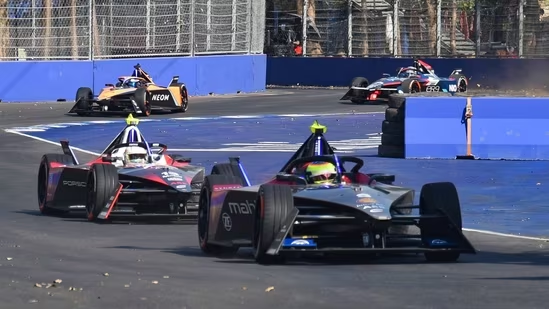Hyderabad to witness Formula E's quiet revolution
As Formula E cars whizzed past with screeching noises during the first practice session of the Hyderabad E-Prix, an eager Formula 1 fan Prasad Reddy told his friend, “This is not like F1 at all. There is no noise.” A Jaguar TCS team member passing by overheard the conversation and responded with a smile: “Welcome to Formula E.”  PREMIUM
PREMIUM
The world’s primary all-electric racing series, which started in 2014 and is currently in its ninth season, uses cars that do not hurt the eardrums like F1 which currently uses hybrid V6 internal combustion engines (ICE).
Formula E, on the other hand, uses cars that are powered by batteries and electric motors, racing on street circuits that allow the maximum amount of braking in comparison to wide and permanent race tracks so that the energy generated while braking is recovered and recharges the batteries. More than 40% of the car’s energy is regenerated through braking with the process continuing through the race.
But it has taken Formula E nine seasons to reach the Gen3 stage. The story started with the Gen1 cars (Spark-Renault SRT_01E) in the first ever season (2014-15) with the chassis being designed by Dallara, battery created by Williams, electric motor made by McLaren, and a Hewland five-speed gearbox with the first season more or less being a single-make series. The cars generated power of 190-200 kW with a maximum speed of 225 kmph. From the second season, manufacturers started building their own components, making the series no more single-make.
Significantly, the Gen1 cars – which were used for the first four seasons – did not have batteries powerful enough to last the entire race which resulted in a peculiar activity. After their car would run out of battery energy halfway through the race, drivers would pit, jump out and enter a second vehicle parked in the garage to continue and finish the race.
“I once broke my finger while jumping in and out of the cars and have bruised my knees or legs multiple times,” laughed two-time Formula E champion Jean-Eric Vergne.
After four seasons with Gen1 cars, Gen2 came into existence with the fifth season in 2018-19 and the weight of the cars reduced from 920kg to 900kg. But the biggest change was that the Gen2 car could last the entire race distance. It generated an additional 60 kW of power (250kW) which made the cars capable of touching speeds in excess of 280kmph. The energy regeneration also increased from 100kW to 250kW.
Formula E introduced Gen3 cars from the current season which have made the vehicles the “most efficient machines on the planet”. The cars have become smaller and lighter, weighing only 840kg (920kg in Gen1 and 900kg in Gen2) with the batteries now generating 350kW of power. The regeneration of energy that comes from braking, rose to an incredible 600kW from 250kW in Gen2 and 100kW in Gen1. Additionally, for the first time, the cars have two motors, propelling both the front and rear wheels which was only the latter in the first two generations of cars, making the cars capable of reaching speeds of up to 320kmph.
“The Gen3 cars are very different. They have two motors instead of one. They can charge at 600kW instead of 250kW. The cars reach speeds of over 300kmph. They are super efficient, using all the regeneration from braking done using the electric motors. Everything put together, it produces a great show,” said former Formula E champion Lucas di Grassi, who races for Mahindra Racing.
Also, linen and recycled carbon fibre are being used in Gen3 bodywork construction for the first time in a formula car, featuring recycled carbon fibre from retired Gen2 cars, reducing carbon footprint of production. Hereon, all waste carbon fibre will be reused for new applications through the adoption of an innovative process from the aviation industry.
A major aspect of why Formula E holds races on temporary street circuits built on public roads in the middle of world cities is because they want to bring electric racing to the people. The purpose is to make the audience realise how electric cars are a viable alternative to fossil fuel-powered vehicles.
"Formula E has the potential to change motorsport in many different ways. From different technology to evolution of the cars which are very complex and fast. They are connected to the highest quality of technology. Formula E has been a great championship which has evolved and grown very fast," said Lucas di Grassi, who is also known as 'Mr Formula E' having raced in all Formula E races held so far.
“It is not the same size as F1 yet but F1 has been around for 73 years while Formula E has only been around for eight. We are in the ninth season. It takes time to create the sport. But I truly believe Formula E will become stronger and stronger because electric vehicles are the future. There is a lot of need to continue the work and development. But the series is going in the right direction.”
Experience unrestricted digital access with HT Premium
Explore amazing offers on HT + Economist Start 14 Days Free Trial Already Subscribed? Sign In
Disclaimer: The copyright of this article belongs to the original author. Reposting this article is solely for the purpose of information dissemination and does not constitute any investment advice. If there is any infringement, please contact us immediately. We will make corrections or deletions as necessary. Thank you.







